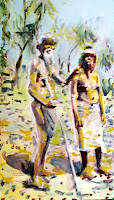




The Top 100 started as a hobby; a fan adoring his musical heroes and paying tribute by making portraits of them. The hobby became obsession and the project went from the boy’s room into the art world. But I'm still that fan, it's about them in the end, their music, and not about me.
 It was an ensemble of Chinese-Americans performing traditional Chinese music in a neighborhood park in Chinatown, Manhattan on a sunny Saturday afternoon.
It was an ensemble of Chinese-Americans performing traditional Chinese music in a neighborhood park in Chinatown, Manhattan on a sunny Saturday afternoon.  And why?
And why?  Because I intuited, maybe for the first time, why music exists and what its function is.
Because I intuited, maybe for the first time, why music exists and what its function is.  I'm a musical tourist.
I'm a musical tourist. The newest of such finds is a book by Henry Sapoznik called Klezmer! Jewish Music from Old World to Our World. The 30th Top 10 of the Top 100 2010 is as follows:
The newest of such finds is a book by Henry Sapoznik called Klezmer! Jewish Music from Old World to Our World. The 30th Top 10 of the Top 100 2010 is as follows:
 only 21 years after Edison's first but 11 years after Emile Berliner's invention of the (flat) phonograph record. While recordings were being made, using this crisp sounding technology, of opera singers and folk ensembles on both sides of the Atlantic, the Torres Strait recordings sound gritty at best.
only 21 years after Edison's first but 11 years after Emile Berliner's invention of the (flat) phonograph record. While recordings were being made, using this crisp sounding technology, of opera singers and folk ensembles on both sides of the Atlantic, the Torres Strait recordings sound gritty at best.


 Mia Zapata (the Gits)
Mia Zapata (the Gits) While You're Twisting, I'm Still Breathing by the Gits. The song is found on the record Frenching the Bully (1992). The painting of Mia Zapata reminded me of a painting I did in 2004 of Ari Up, singer of the Slits. It was my favorite painting for the Top 100 2003 for the same reasons as this one of the Gits. To the right is a small reproduction of that Ari Up painting, it's about 16 inches tall, also done in oils.
While You're Twisting, I'm Still Breathing by the Gits. The song is found on the record Frenching the Bully (1992). The painting of Mia Zapata reminded me of a painting I did in 2004 of Ari Up, singer of the Slits. It was my favorite painting for the Top 100 2003 for the same reasons as this one of the Gits. To the right is a small reproduction of that Ari Up painting, it's about 16 inches tall, also done in oils.


